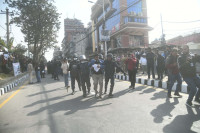Opinion
Options required
The Nijgadh airport, planned to relieve air traffic at Kathmandu, is years behind in development
Ashish Gajurel
On March 12, 2018, a US-Bangla Airlines aircraft flying from Shahjalal International Airport, Dhaka, Bangladesh crashed at Tribhuvan International Airport (TIA) and 52 people were killed. This crash has raised serious concerns over air safety and air traffic management in Nepal. Due to the lack of alternative international airports in Nepal, those flights affected by this crash had to be diverted to those airports in neighbouring countries. The physical infrastructure and facilities available in our country’s only international airport are extremely weak compared to most other countries’ airports, furthermore, the geography in which it is situated renders it particularly difficult to land and take-off from.
According to Spanish consulting company INECO, TIA can handle traffic growth only till the year 2021 as annual international air traffic at TIA is expected to reach 10 million passengers by then. This problem has also been identified by Nepali authorities and a detailed feasibility study of a proposed second international airport in Nijgadh (SIA) was conducted in 2011. However, the construction of this airport has not yet begun, though activities like land acquisition, compensation, re-settlement and environmental impact assessment are ongoing. The recent plane crash has further highlighted the need for at least one other international airport. In order to avoid such tragedies again and in order to achieve a position wherein Nepal can host the exponential growth in air traffic, Nepal needs to act immediately to develop the SIA.
Case studies from developed countries reveal that private sector involvement is vital for the development of large scale public infrastructure. Private sector expertise and finance must be mobilised if development is to occur within the country. Nepal is lagging behind in developing major infrastructure due to a lack of capital, lack of necessary long-term vision, lack of implementation capacity, and lack of necessary technology and manpower. The government is not able to properly utilise the allocated capital investment budget. The government has only been able to spend 28 percent of its total capital budget in the past seven months of the fiscal year, which is a dismal figure.
The Detailed Feasibility Study Report (2011) shows that the first phase of the Nijgadh airport will cost around Rs65 billion and this single runway airport will be able to handle 15 million passengers per year. The study has envisioned three phases of development. The government should swiftly begin preparations for the construction and operation of the first phase immediately.
Undeniable need
Nepal’s infrastructure sector is highly under-developed. Consequently, the need for infrastructure investment in Nepal is so high that it will require all possible sources to be tapped, including private investments. Energy and transport are the main areas where investments are required on a priority basis, because investment in these sectors will have an impact on other economic sectors.
The need for an SIA in Nepal has been long discussed. In 2017, 3.88 million international passengers travelled through TIA, which is a 10.74 percent increase over the previous year. Nepal’s long term aim is to increase the number of tourists coming to Nepal. This will mean that Nepal needs to increase the capacity of the airport or develop alternative international airports. Due to the limitation of the capacity of TIA because of its geographic location and available land, an alternative international airport should be a priority. In addition, if a major infrastructure project is established outside the capital, it will enhance the development of the surrounding regions and will strengthen federalism.
However, despite the government designating the airport at Nijgadh as a “national pride project” years ago, there has been negligible progress in starting its development activities. The airport will provide thousands of jobs and also develop Nijgadh as an air traffic hub. The airport will not only generate employment but improve the country’s revenue and overall economy. There is no doubt that the contribution of this airport will be important.
Currently, 30 percent of all airports in the world are operated under Public Private Partnerships (PPP) model and by 2025, the number will reach 50 percent. The major airports of our neighbouring countries are successful examples of PPP in building airport infrastructure. For instance, construction and operation of airports including Delhi, Mumbai, Saudi Arabia’s Medina, and the Queen Alia in Jordan have been built in this fashion. Therefore, it seems appropriate to develop Nijgadh through PPP as well.
Why include the private sector?
Involvement of a reputed and capable private sector airport developer and operator will enhance service quality and passenger experience through contractually enforced performance standards and through natural commercial incentives for private investors and operators.
The major agenda of economic prosperity and implementing federalism will only be achieved via the development large infrastructure projects. Such huge developments are not possible using government resources alone. Therefore, Nepal should utilise private national and foreign investments as well as the experience of the private sector to develop the nation. The government can still manage activities such as immigration, customs, security and air traffic communication while the private sector operates and manages the airport under a PPP arrangement. The current share of non-aeronautical revenues of TIA is around 15-20 percent of the total revenue, compared to about 70 percent in the world’s best airports and 30-40 percent in comparable airports. Private sector participation will certainly improve this scenario.
While opportunities for the private sector to invest in such big projects exist, there are associated risks as well. The private sector is profit-oriented. The government’s role in PPP will be to facilitate, regulate, supervise and control the private sector. As already mentioned above, there are many examples of airports that are being operated successfully through PPP.
The TIA and the SIA will impact each other’s viability and investment plans. Integrated SIA cum TIA development will aid the government in making well informed decisions on the size and timing of investments at both TIA and SIA. Therefore, an integrated approach is required through a consensus based, well-coordinated action plan for the up-gradation of the TIA and for the development of the SIA.
Gajurel is a transportation and traffic engineer




 6.12°C Kathmandu
6.12°C Kathmandu










